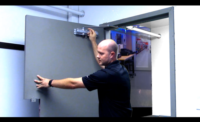For many integrators, door and lock hardware is a mysterious thing best left to the locksmith professionals — but that can leave money and opportunity on the table. Dealers and integrators who come from the electronic access control, alarm and video side of the security business are increasingly looking at providing the whole picture — including the hardware — themselves.
Competition and profit figure heavily into the decision.
“Locksmiths have the ability, technique and understanding of doors,” explains Robert Lovato, technical support manager, Security Door Controls (SDC), Camarillo, Calif. “They know latches and hinges, closing speeds, etc. I find that a lot of the alarm guys are terrified of hardware and the locksmith guys in turn are terrified of wires.”
But this is beginning to change, he says. “What I see is a boldness coming more from the electronic security guys that are trying to be all encompassing. I see some of these guys starting to dabble and step across to the hardware side. It’s like they were just peeking over the fence before. Some of them I am starting to see the full body now.”
While the migration isn’t happening as much on the locksmith-to-electronic side, they too are starting to look at the benefits of being a one-stop shop, creating some competitive scenarios.
“Absolutely more integrators are doing more of their own lock work now,” says Keith Lathrop, business development manager, Midwest Wholesale Hardware, Kansas City, Mo. “I have been in this business for a little more than 30 years and for a lot of those years they would subcontract to a locksmith or hardware company. But as some of those folks started to get into the integration business, all of a sudden there is more reluctance to sub out to someone who could potentially be a competitor on the job.”
Another pull to the hardware side that has come up in recent years is the popularity of all-in-one locks that incorporate the reader, the electronics and the hardware into one unit. These “hybrid” products mean that integrators either lose out on the whole door or they learn to install locks on a door and frame.
“People resist change,” says John Hunepohl, director of education, ASSA ABLOY, New Haven, Conn. “They have always done things a certain way. But with more integrated technology and products, they have to get on board and ask, ‘How do I make money at this thing?’ Right now, if they do business the old way, you have the general contractor making money on doors and locking devices and the integrator makes nothing except on the wiring. When you say ‘This is electronic access control,’ what are you controlling access to and through? Doors. Why put your head in the sand and act like the door is not part of your job?”
Own the Door
For the dealer or integrator willing to invest the time and training in learning to do the hardware installation, there are several benefits.
“It is a really good revenue stream,” says Gary Roebuck, ADI Systems Specialist, ADI, Melville, N.Y. “Not only are you selling all the other door components, if you also include the lock and service to that lock, it becomes a true end-to-end solution. If I were an integrator I would want to do that because otherwise it is just leaving dollars on the table they could be capturing.”
Hunepohl agrees. “The question is why wouldn’t you want to have total ownership and offer this? We as an industry are moving beyond just the door with products. We have products for server racks and cabinets as well. If I can’t provide a total solution I might not even be invited to bid. My recommendation is to not sub it out. It is your customer.”
This was the conclusion integrators Steve Beaudry, director of physical security integration and Dave Stern, physical security manager, Technology Resource Advisors, Inc., Milwaukee, came to several years ago when they took the hardware and lock installation in house.
“The problem we came across was that too many subcontractors make things difficult to manage,” Beaudry says. “We have streamlined that. There is a lot of loss margin with a third party. Now not only are we adding to our profit, but we also are adding those extra pieces to it and building a better relationship with our clients.”
Bringing Lock Installation In-House
The first step to learning how to install locks and hardware is to get some expertise. There are several ways of accomplishing this, from hiring talent to taking one or several courses from manufacturers or associations, to working alongside a locksmith and learning as you go.
“If the integrator or dealer is properly trained and educated, they can install it themselves,” says Matt Ehrman, access control specialist, Tri-Ed Distribution, Woodbury, N.Y. “However, if they are not educated properly, the cost of mistakes would far exceed the cost of doing it themselves.”
The American Locksmithing Association of America offers classes, as do several other trade associations. Manufacturers also offer training on their products.
One popular option is to have a designated staff person, whether they are hired with the experience or trained later, says Eric Elsenbroek, systems sales support manager who leads ADI’s systems sales and support team, Melville, N.Y. “Our integrators often have someone on staff with locksmith experience, which is a great thing — a ‘train the trainer’ scenario. ADI also offers a lot of Expo classes. And we rely on our vendor partners to provide education at a mass or individual level. If someone comes to us with their first real job we partner them with a vendor who can hand hold them through it a couple of times. There are lots of options.”
Most classes are no or minimal charge, Lathrop adds. “The real expense is in the technician’s time. The integrator has to dedicate the resources for it and training is a very valuable and necessary thing to budget for.”
At Beaudry’s facility everyone goes through certification. “New guys are certified as they come in so we can be a one-stop shop.”
In order for an integrator or dealer to become comfortable with the hardware installation side, some of what they need to learn is basic locksmithing 101. They don’t need to be a full locksmith, but they do need to be comfortable with certain scenarios, Hunepohl says.
“When they come in and do training they have to become carpenters in a way. They have to know how to drill a hole in wood. Sometimes they don’t understand drill speeds. If they don’t know that stuff, we teach it to them.”
Lovato says one of the key things to learn for an integrator is the design of an opening and the parts that go into it. “They need to know all the components that make up the door and all the pieces to the equation. They need to become familiar with the interplay of all the door hinges, understand the alignment of the door and how to realign the door, understand the in-the-floor door closers, above the door, surface mount, etc.”
Knowing the parts is key to getting the right materials the first time.
“Sometimes they have more of a problem trying to figure out the exact material they need,” Lathrop says. “An accurate bill of material is critical to make sure their costs are covered. Even if one item costs the same as another, if you have the wrong piece, it’s a waste of the technician’s time.”
The biggest key is to make sure you have the right people with the right training for the job.
“I would just say to the integrator ‘Hire some skill,’” Hunepohl adds. “We did this back in the ‘90s with networks. Back then they had always purchased the computer from the access control manufacturer. Suddenly the customer was supplying their own computer and the IT guy didn’t want anything on those computers they didn’t understand, including access control. Any system integrator today has a Microsoft-certified person on staff to handle these problems. Now they are going to have to do the same thing with doors.”
It can take some intentional training and hiring, but once complete the profit and relationship boost that can be experienced from bringing the door lock and hardware installation in-house can be long term and well worth all the effort.
Tricks of the Trade
With a little experience, integrators can learn to do the job as well as the pros, and that includes both speed and craftsmanship.
“We have subcontractors that can modify doors in less than 45 minutes,” says John Hunepohl, ASSA ABLOY. “How do they do it? If I were going to do 1,000 doors, I would have one person that is the senior installer. They won’t be drilling the holes. They will assign one guy to drill the half inch holes and another for the inch holes and so on in a production line. That is the way you do it. You don’t completely install one door at a time.”
Another option is to order the doors pre-cut, when the situation allows for it. “Send templates to the door manufacturers and have them pre-fab those doors and frames, then all you have to do is finish it by installing the lock itself and you know for sure everything will be cookie cutter,” says ADI’s Eric Elsenbroek. “This is particularly helpful for larger jobs. Manufacturers will charge for it, but the time saving on labor alone will be well worth it.”
Integrated locksets that incorporate the door lock, hardware, request to exit, door contact all in one can also be a time saver. “All you are doing is installing a lock, running wire and you are ready to go, Elsenbroek says. “They are more expensive, but when you understand the labor savings and consolidation, it can really make or break a project,” he adds.
On the flip side, there are also some pitfalls to avoid.
“Some of the things they might do to the door could cause them to have to buy a new door because they didn’t realize that drilling a hole in the door could void the fire rating,” Lovato says. “They also need to know a thing or two about door closing speeds for ADA.”
The most common trip-ups are product selection based on the hardware on the door, says Matt Ehrman, Tri-Ed Distribution. “Knowing the type of hardware and matching it to the electrified locksets/strikes is crucial.”
Gary Roebuck, ADI, agrees “Selecting the right lock is one of the biggest trip-ups. If the integrator is not experienced they might think an $80 strike is just as good as a $300 one, but they are each meant for specific applications. They don’t mix and match. Pick the $80 and realize you need the $300 and that can be a huge misstep.”
Knowing the pre-installation condition of the door and hardware is equally important. A door that doesn’t close properly because of warping or faulty hinges, for example, won’t be secure no matter what hardware you put on it.
“Make sure the door is functioning properly before you put the hardware on it,” says Dave Stern, Technology Resource Advisors. “And make sure all the hardware is functioning as intended pre-installation.”
With the right knowledge, experience and help, an integrator can have a successful installation.
“Planning and training are the two parts that folks are a little short on that can make or break a successful hardware installation,” says Steve Beaudry, Technology Resource Advisors.
Tools to Use
Every installer has specific tools of the trade, and locksmiths are no exception. Integrators who plan to install hardware may need to invest in a few specialized tools that aren’t already in their arsenal.
“There are tools that the locksmith industry has like hard steel templates and specialized saws,” says Gary Roebuck, ADI. “Integrators may think they can do it with a saws-all and a hammer, but there are a bunch of specialized tools and jigs and templates that can be had to make life easier.”
The right tools for the job are crucial, says John Hunepohl, ASSA ABLOY. “All locks come with paper templates. You have to learn how to stick them on and measure. Pro-Lok and Major Manufacturing offer metal clamp-on templates. Locksmiths have used those for years. Paper can be problematic. If you don’t get it taped on exactly right then the holes are wrong.”
For integrator Steve Beaudry, Technology Resource Advisors, these tools have been job savers. “One of the things that has really helped us is the use of door jigs and templates from third-party manufacturers. Our error rate is very low. The investment has paid for itself many times. Using a door jig, we have cut our installation time in half. Invest in these. It gives the installers a little more comfort level and confidence in the work they are doing.”














